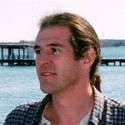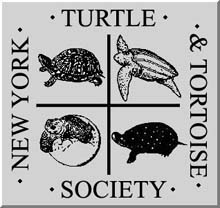 |
 |
The New York Turtle and Tortoise Society announces

Seminar 2006

Saturday, March 18, 2006
Registration 9:30 a.m.; Sessions 10:00 a.m.–5:00 p.m.

The Kaufman Theater, American Museum of Natural History
79th at Central Park West, New York City
(Enter through security entrance under stairs on Central Park West.)
|
The New York Turtle and Tortoise Society’s nineteenth Annual Seminar, a full-day event, featured four presentations and was held at the American Museum of Natural History. On Manhattan’s Upper West Side, easily accessible by public transportation, the Museum has been the site of our regular monthly meetings for 30 years. Visit the Museum’s Web site (amnh.org) and Natural History magazine (naturalhistorymag.com).
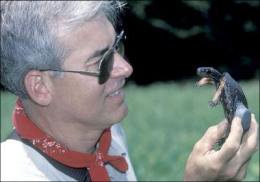
John Behler with spotted turtle (WCS photo) |
 The New York Turtle and Tortoise Society is dedicating Seminar 2006 to the memory of John L. Behler, who died on January 31, 2006. An inveterate turtle conservationist and friend to the Society, John will be greatly missed. A period of time will be set aside during the Seminar for the showing of slides and tributes in his honor.
The New York Turtle and Tortoise Society is dedicating Seminar 2006 to the memory of John L. Behler, who died on January 31, 2006. An inveterate turtle conservationist and friend to the Society, John will be greatly missed. A period of time will be set aside during the Seminar for the showing of slides and tributes in his honor.
Long-time Curator of Herpetology for the Wildlife Conservation Society, he came to the Bronx Zoo in 1970. Serving many years as Chairman of the IUCN/SSC Tortoise and Freshwater Turtle Specialist Group, he sounded an early clarion call that the living chelonians of the world are in perilous decline. His deep concern for the worldwide loss of turtle populations prompted his tireless efforts to save them, and he will certainly be remembered as a hero of turtle conservation.

Slides shown at the meeting are reproduced below. |
|
| Scheduled Program |

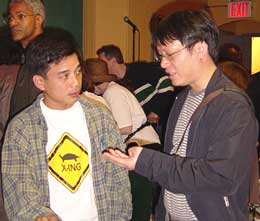
Minh Duc Le (right) with Asian Scholarship recipient Trung Canh Luu at the 2003 Turtle and Tortoise Show |
 Minh Duc Le
Minh Duc Le
Ph.D. Candidate, Department of Ecology, Evolution, and Environmental Biology, and Department of Herpetology, American Museum of Natural History; and Center for Environmental Research & Conservation, Columbia University

“Turtle Conservation in Vietnam — A Survey of Cat Tien
National Park and Vo Doi Nature Reserve”

Turtles in Southeast Asia, especially in Vietnam, have been overexploited for more than a decade largely due to the international trade with China. To better protect the remaining turtle populations, this study surveyed populations in two protected areas in Southern Vietnam, Cat Tien National Park and Vo Doi Nature Reserve, and assessed local trade levels in surrounding areas.
The results show that although local trade of turtles is extensive, viable turtle populations still exist in the protected areas. However, these populations are in need of immediate conservation measures to protect them, and increased protection levels in protected areas is probably the most effective way to protect the last turtle populations in Vietnam as well as in other countries in Asia. But for long-term conservation goals, other measures, such as trade control, environmental education in buffer zones, and raising people’s awareness, should also be emphasized.

 |
 |
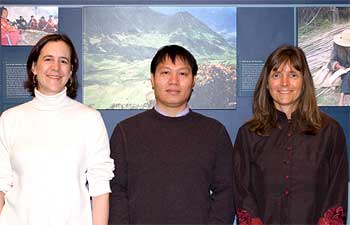

Martha M. Hurley (biodiversity scientist), Minh Duc Le, and Eleanor J. Sterling (Director), Center for Biodiversity and Conservation, American
Museum of Natural History. Photo by Peter Ersts |
|

“Phylogenetic Relationships of the Turtle Family Geoemydidae (Testudines: Testudinoidea)”
The turtle family Geoemydidae Theobald 1868 (previously known by the name Bataguridae Gray 1870) is the most diverse group of living turtles, encompassing about 70 described species and 23 genera (more than one-fifth of the world’s species). Although many studies have been conducted over last 40 years, the phylogenetic relationships of this group have remained contentious. Specifically, the monophyly of Geoemydidae has not been supported by previous molecular and morphological analyses. To address this problem, this study employed both molecular and morphological data, and we have found that the monophyly of this group is strongly supported. The family’s biogeographic history and its relationship with other sister families, Emydidae and Testudinidae, will be discussed.
|


 |
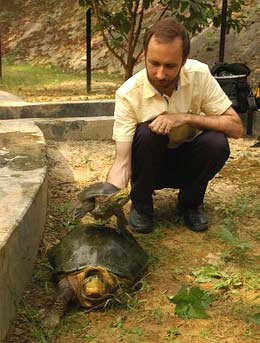
Peter Paul van Dijk at the Gharial Center in Kukrail, near Lucknow, India, with an adult pair of red-crowned roof turtles, Kachuga kachuga. Photo by Brian Horne |
 Peter Paul van Dijk
Peter Paul van Dijk
Director, Tortoise and Freshwater Turtle Conservation Program,
Center for Applied Biodiversity Science,
Conservation International

“Asian Turtle Trade — Recent Developments”

After the mass harvest of wild Asian turtles became known in the 1990s, a variety of conservation and trade management measures were implemented, ranging from trade legislation and harvest management to commercial farming and assurance colonies. This presentation will give an overview of these developments, discuss their contribution to safeguarding Asia’s wild turtle populations, and consider the outlook for the future.

Peter Paul van Dijk has been the Director of Conservation International’s Center for Applied Biodiversity Science (CABS) Tortoise and Freshwater Turtle Conservation Program since November 2004.
He has been active in the research and conservation of Asian tortoises and freshwater turtles since 1990. He presented a paper on Turtle Conservation in Myanmar at the 1993 Conservation, Restoration, and Management of Tortoises and Turtles international conference in Purchase, New York. He has conducted ecological research on elongated tortoises and other turtles in western Thailand, turtle status surveys in Thailand, Myanmar, and Malaysia, and turtle trade surveys and analysis through much of Asia. In 1998 he co-authored a simple field guide to the reptiles of Thailand, Peninsular Malaysia and Singapore. From 1999 to 2002 he worked at TRAFFIC Southeast Asia in Malaysia, analyzing trends in turtle trade and farming, assisting the inclusion of Asian turtle species in the CITES Appendices, and editing publications such as Asian Turtle Trade and the proceedings of the Kunming CITES turtle trade workshop.
In addition to his current work with CABS, Dr. van Dijk also serves as deputy chair and program officer of the IUCN/SSC Tortoise & Freshwater Turtle Specialist Group.
|


 |
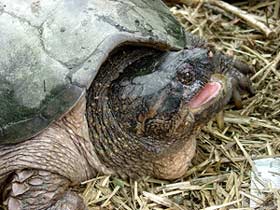
Hudson River Snapper—“Big Poppa” |
 Christopher Rowe
Christopher Rowe
Associate Professor, Chesapeake Biological Laboratory,
University of Maryland Center for Environmental Science

“Reproductive Ramifications of PCBs
in Hudson River Snapping Turtles”

This project examines relationships between PCB accumulation by snapping turtles (Chelydra serpentina) in the Hudson River and biological responses related to performance and reproductive fitness. The primary research question that we are addressing is “Do natural systems contaminated by high concentrations of PCBs present biological risks to wild populations via disruptions of normal reproductive processes?” We are employing a multifaceted approach that includes molecular, cellular, physiological, developmental, and autecological assessments of snapping turtles inhabiting PCB contaminated and relatively uncontaminated portions of the Hudson River. Our overall goal is to determine whether there are potential fitness-related effects of PCBs on endemic reptile populations in the Hudson River.

Specific Topics of Study:
- Bioaccumulation and maternal transfer to offspring of PCBs in a natural system;
- Sexual morphology and circulating hormone concentrations in adult turtles inhabiting the system;
- Thyroid dynamics in hatchlings receiving maternally-derived PCBs;
- Morphology and behavior of hatchlings;
- Long-term bioenergetic and growth responses of hatchlings;
- Cellular and subcellular effects of PCBs in hatchlings.
Christopher Rowe has been conducting research on the physiological ecology and toxicology of reptiles and amphibians for 15 years. He conducted his graduate studies at The Pennsylvania State University with Dr. William Dunson, and his post-doctoral work at the University of Georgia's Savannah River Ecology Laboratory with Dr. Justin Congdon. His recent and ongoing studies with turtles include the effects of persistent organic compounds (PCBs, BDEs) on developmental, bioenergetic, and behavioral traits of snapping turtles and painted turtles. He also has recently initiated a study in which snapping turtles and diamondback terrapins are being used as models to examine the effects of near-shore oil spills on sea turtle nests. |


 |
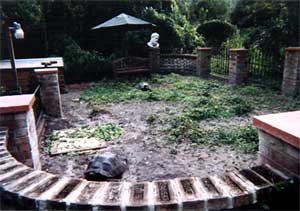
Newly completed tortoise pen at the
Chelonian Research Institute |
 Peter C. H. Pritchard
Peter C. H. Pritchard
Chelonian Research Institute, Oviedo, Florida

“A Tour of the Chelonian Research Institute”

The well-known author of the Encyclopedia of Turtles and many other books on turtles is one of the world’s foremost experts on turtles and tortoises. Since its establishment by Peter Pritchard in the 1998, the Chelonian Research Institute in Oviedo, Florida, has grown to become the world’s most complete collection of turtle specimens. Recently augmented by a contribution of 2,000 additional specimens from the state of Vera Cruz, Mexico, it now houses 11,500 catalogued items, representing every turtle genus and 95 percent of the world’s known turtle species. Noteworthy is the fact that that turtles weren’t killed to become part of the collection, but were salvaged from deceased turtles in the wild or from the collections of turtle hobbyists.
Not all the Institute’s turtles are preserved specimens. Young hatchlings swimming in aquariums are on display in the foyer, and large tortoises enjoy a newly completed pen on the Institute grounds. Peter’s actual home across the street houses Galápagos tortoises and several alligator snapping turtles, along with myriad other species. Peter will present a tour of the Institute, giving a true sense of the extent of the world’s largest turtle specimen collection.

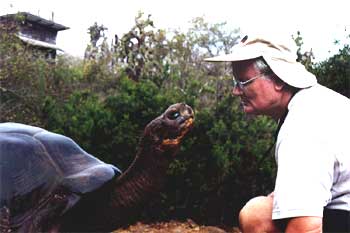
A very old, nearly blind Duncan Island tortoise challenges Peter Pritchard (Galápagos Islands)
|
 Peter has spoken numerous times at NYTTS Annual Seminars since 1987, covering such diverse turtle topics as “Turtles and Tortoises of Australia,” “Tortoises of Aldabra,” “In Search of Chitra indica,” “The Giant Tortoises of the Galápagos,” “Sea Turtle Conservation in Guyana,” “On the Trail of Rafetus swinhoei, the World’s Rarest and Largest Freshwater Turtle,” “The Turtle Crisis in Southeast Asia,” and “The Pinta Island Tortoise, In Search of a Mate for Lonesome George.”
Peter has spoken numerous times at NYTTS Annual Seminars since 1987, covering such diverse turtle topics as “Turtles and Tortoises of Australia,” “Tortoises of Aldabra,” “In Search of Chitra indica,” “The Giant Tortoises of the Galápagos,” “Sea Turtle Conservation in Guyana,” “On the Trail of Rafetus swinhoei, the World’s Rarest and Largest Freshwater Turtle,” “The Turtle Crisis in Southeast Asia,” and “The Pinta Island Tortoise, In Search of a Mate for Lonesome George.”
Through his scientific and popular writing, his films, and his speaking engagements, Peter has made turtles popular in the public mind, greatly increasing support for their conservation. In 2000, Time Magazine declared him a “Hero of the Planet.”
|
|
 |
|







